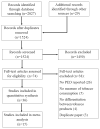Price elasticity of demand of non-cigarette tobacco products: a systematic review and meta-analysis
- PMID: 29363611
- PMCID: PMC6056338
- DOI: 10.1136/tobaccocontrol-2017-054056
Price elasticity of demand of non-cigarette tobacco products: a systematic review and meta-analysis
Abstract
Objective: To systematically review the price elasticity of demand of non-cigarette tobacco products.
Data sources: Medline, Embase, EconLit and the Web of Science without language or time restrictions.
Study selection: Two reviewers screened title and abstracts, then full texts, independently and in duplicate. We based eligibility criteria on study design (interventional or observational), population (individuals or communities without geographic restrictions), intervention (price change) and outcome (change in demand).
Data extraction: We abstracted data on study features, outcome measures, statistical approach, and single best own- and cross-price elasticity estimates with respect to cigarettes. We conducted a random effects meta-analysis for estimates of similar product, outcome and country income level. For other studies we reported median elasticities by product and country income level.
Data synthesis: We analysed 36 studies from 15 countries yielding 125 elasticity estimates. A 10% price increase would reduce demand by: 8.3% for cigars (95% CI 2.9 to 13.8), 6.4% for roll your owns (95% CI 4.3 to 8.4), 5.7% for bidis (95% CI 4.3 to 7.1) and 2.1% for smokeless tobacco (95% CI -0.6 to 4.8). Median price elasticities for all ten products were also negative. Results from few studies that examined cross-price elasticity suggested a positive substitution effect between cigarette and non-cigarette tobacco products.
Conclusions: There is sufficient evidence in support of the effectiveness of price increases to reduce consumption of non-cigarette tobacco products as it is for cigarettes. Positive substitutability between cigarette and non-cigarette tobacco products suggest that tax and price increases need to be simultaneous and comparable across all tobacco products.
Keywords: economics; hand-rolled/ryo tobacco; non-cigarette tobacco products; price; taxation.
© Article author(s) (or their employer(s) unless otherwise stated in the text of the article) 2018. All rights reserved. No commercial use is permitted unless otherwise expressly granted.
Conflict of interest statement
Competing interests: None declared.
References
-
- National Cancer Institute and WHO. [accessed 02 Feb 2017];NCI Tobacco Control Monograph Series 21 - The Economics of Tobacco and Tobacco Control [online] 2017 Available at http://bit.ly/2jtRXts.
-
- Rice N, Godfrey C, Slack R, et al. A systematic review of the effects of price on the smoking behaviour of young people. York: Public Health Research Consortium; 2010.
-
- Wilson N, Thomson G. Tobacco tax as a health protecting policy: a brief review of the New Zealand evidence. N Z Med J. 2005;118:U1403. - PubMed
-
- Chaloupka FJ, Straif K, Leon ME Working Group, International Agency for Research on Cancer. Effectiveness of tax and price policies in tobacco control. Tob Control. 2011;20:235–8. tc. 2010.039982. - PubMed
Publication types
MeSH terms
Grants and funding
LinkOut - more resources
Full Text Sources
Other Literature Sources

